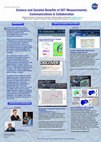Papers by William Patzert
2015 AGU Fall Meeting, Dec 17, 2015
AGU Fall Meeting Abstracts, Dec 16, 2014

Proceedings of SPIE, Aug 1, 1984
The global view of the oceans seen by Seasat during its 1978 flight demonstrated the feasibility ... more The global view of the oceans seen by Seasat during its 1978 flight demonstrated the feasibility of ocean remote sensing. These first-ever global data sets of sea surface topography (altimeter) and marine winds (scatterometer) laid the foundation for two satellite missions planned for the late 1980's. The future missions are the next generation of altimeter and scatterometer to be flown aboard TOPEX (Topography Experiment) and NROSS (Navy Remote Ocean Sensing System), respectively. The data from these satellites will be coordinated with measurements made at sea to determine the driving forces of ocean circulation and to study the oceans role in climate variability. Sea surface winds (calculated from scatterometer measurements) are the fundamental driving force for ocean waves and currents (estimated from altimeter measurements). On a global scale, the winds and currents are approximately equal partners in redistributing the excess heat gained in the tropics from solar radiation to the cooler polar regions. Small perturbations in this system can dramatically alter global weather, such as the El Niho event of 1982-83. During an El Ni?io event, global wind patterns and ocean currents are perturbed causing unusual ocean warming in the tropical Pacfic Ocean. These ocean events are coupled to complex fluctuations in global weather. Only with satellites will we be able to collect the global data sets needed to study events such as El Ni?o. When TOPEX and NROSS fly, oceanographers will have the equivalent of meteorological high and low pressure charts of ocean topography as well as the surface winds to study ocean "weather." This ability to measure ocean circulation and its driving forces is a critical element in understanding the influence of oceans on society. Climatic changes, fisheries, commerce, waste disposal, and national defense are all involved.

AGU Fall Meeting Abstracts, Dec 1, 2014
Climate Change, Pacific and Landuse Influences on Los Angeles’ Urban Heat Islands Brandi Gamelin1... more Climate Change, Pacific and Landuse Influences on Los Angeles’ Urban Heat Islands Brandi Gamelin1, Freddy Hsu1, Steve LaDochy1, Pedro Ramirez1, Hengchun Ye1, Pedro Sequera2, Jorge E. González2, Kyle McDonald2, William Patzert3 1Department of Geosciences & Environment, California State University, Los Angeles, California 2Department of Mechanical Engineering, The City College of New York, CUNY, New York, New York 3Jet Propulsion Laboratory, NASA Abstract The Los Angeles urban heat island (UHI) is a complex entity that is changing in time, space and intensity. The major influences on its characteristics appear to be population, landuse, and Pacific Ocean variability. Since 1950, the city of Los Angeles has nearly tripled in population from 1,333,300 to 3,792,621 in 2010. The downtown skyline has also changed as more highrises replaced lower density buildings and parking lots. Downtown average temperatures have increased rapidly, rising over 3oC in the last century. Tmin values have increased faster than Tmax similar to other UHI cities. But the LA UHI is unique among most cities, with complex terrain and dominant land/sea breeze circulations. Also, the city is part of a regional megalopolis, where the surrounding rural areas found in most UHIs are distant and ill-defined. Our study looks at the diurnal and seasonal patterns in the urban termal regime and how it has changed over several decades. Temporal changes in landuse, particularly vegetation, coastal sea surface temperatures, Pacific climatic índices (SOI, PDO, NOI) and coastal upwelling all seem to contribute to the changes in city temperatures. The Pacific Decadal Oscillation (PDO) correlates well with Los Angeles temperatures (LaDochy et al. 2007). The spatial changes in the UHI are also described combining surface met data and aircraft remote sensing, using the Airborne Visible/Infrared Imaging Spectrometer (AVIRIS) and the MODIS/ASTER Airborne Simulator (MASTER) sensors at spatial resolutions of 30 and 50 m, respectively. Recent sea breeze enhancement may also influence spatial patterns of the UHI including recent coastal cooling (Sequera et al. 2014). Implications of the role of the intensifying UHI in the increases in LA heat waves (Tamrazian et al. 2000) will also be discussed.

ighteen years of ocean surface topography (OST) measurements brings us the formal migration to an... more ighteen years of ocean surface topography (OST) measurements brings us the formal migration to an operational mode from the technological advances the OST missions have delivered. After the third anniversary of the launch of OSTM/Jason-2, we now look forward to the launches of the operational Jason-series satellites. Jason-3 is projected to launch in 2014 with NOAA and Eumetsat leading the efforts, along with partners NASA and CNES. Plans for Jason-4, Jason-CS, and SWOT are underway. It is increasingly relevant to focus attention and to promote the science and societal benefits of the OST missions. This has been primarily achieved through web interfaces, media stories based on research results, OSTST member activities, and mission milestones. We advance awareness and visibility of OST mission science by focusing on the direct benefits of these measurements to society. As we focus our attention on current datasets and future missions, we urge OSTST members to partner with the Outreac...

The goal of this research is to monitor the health and vigor of coral reef ecosystems, and their ... more The goal of this research is to monitor the health and vigor of coral reef ecosystems, and their sensitivity to natural and anthropogenic climate changes. To achieve these lofty goals, this research is investigating the feasibility of using spaceborne high-resolution spectrometers (on the US Landsat, French Systeme Probatoire pour l'Observation de la Terre [SPOT] and/or the Indian Resources Satellite [IRS 1C & 1D] spacecraft) to first map the aerial extent of coral reef systems, and second separate the amount of particular corals. If this is successful, we could potentially provide a quantum leap in our understanding of coral reef systems, as well as provide much needed baseline data to measure future changes in global coral reef ecosystems. In collaboration with Tomas Tomascik, Yann Morel, and other colleagues, a series of experiments were planned to coordinate in situ coral observations, high-resolution spaceborne imagery (from Landsat, SPOT, and, possibly, IRS IC spacecraft), and NASA Space Shuttle photographs and digital images. Our eventual goal is to develop "coral health algorithms" that can be used to assess time series of imagery collected from satellite sensors (Landsat since 1972, SPOT since 1986) in concert with in situ observations. The bad news from last year was that from 1997 to mid- 1998, the extreme cloudiness over southeast Asia due to prolonged smoke from El Nino-related fires and the economic chaos in this region frustrated both our space and reef-based data collection activities. When this volatile situation stabilizes, we will restart these activities. The good news was that in collaboration with Al Strong at the National Oceanic and Atmospheric Administration (NOAA) we had an exciting year operationally using the NOAA's Advanced Very High Resolution Radiometer sensor derived sea surface temperature products to warn of coral "bleaching" at many locations throughout the tropics. Data from NOAA's satellites showed that during the El Nino of 1997 and the first half of 1998, more ocean area in the tropics experienced exceptionally high sea surface temperatures, or "hot spots," than have been observed in any fall year since the El Nino of 1982. From January to July, the coral bleaching events were concentrated in the Southern Hemisphere (during its warm season). Since July 1998, the reports of extensive coral bleaching have again spread into regions of the Northern Hemisphere following abnormally high sea surface temperatures, especially around the Philippines and throughout the Caribbean Basin, Bahamas, Bermuda and Florida Keys. These El Nino induced events clearly demonstrated that corals are the "canaries of the marine ecosystem," highly sensitive to short-term natural climate events (El Nino), and should be monitored as measures of longer-term environmental and climate change. Additional information is contained in the original.

The CSULA Departments of Geography and Geological Sciences, in cooperation with the Charter Colle... more The CSULA Departments of Geography and Geological Sciences, in cooperation with the Charter College of Education at CSULA, propose to introduce the Earth System Science Education Alliance (ESSEA) On-line course for middle school teachers as a section of our undergraduate pre-service teacher course, PSCI 183: Earth Science for Elementary Teachers. Physical Science 183 was proposed as an activities and inquiry- based course for students needing an earth science foundation, but in an active learning environment. We have developed two ESSEA education modules centered on climate change and natural variability and on tsunami. The climate change module is based on a scenario in which students are part of a climate change advisory committee charged with providing the scientific framework for climate change. Students learn to distinguish between natural variability in the Pacific Ocean and trends in global climate change. Components of the module focus on interpreting trends in temperature, ...

The Earth System Science Education Alliance (ESSEA) recently developed a set of climate related e... more The Earth System Science Education Alliance (ESSEA) recently developed a set of climate related educational modules to be used by K-12 teachers. These modules incorporate recent NASA and NOAA resources in Earth Science education. In the summer of 2011, these modules were tested by in-service teachers in courses held at several college campuses. At California State University, Los Angeles, we reviewed two climate modules: The Great Ocean Conveyer Belt and Abrupt Climate Change (http://essea.strategies.org/module.php?module_id=148) and Sulfur Dioxide: Its Role in Climate Change (http://essea.strategies.org/module.php?module_id=168). For each module, 4-6 teachers formed a cohort to complete assignments and unit assessments and to evaluate the effectiveness of the module for use in their classroom. Each module presented the teachers with a task that enabled them to research and better understand the science behind the climate related topic. For The Great Ocean Conveyer Belt, teachers ar...

Recent Advances in Civil Space Remote Sensing, 1984
The global view of the oceans seen by Seasat during its 1978 flight demonstrated the feasibility ... more The global view of the oceans seen by Seasat during its 1978 flight demonstrated the feasibility of ocean remote sensing. These first-ever global data sets of sea surface topography (altimeter) and marine winds (scatterometer) laid the foundation for two satellite missions planned for the late 1980's. The future missions are the next generation of altimeter and scatterometer to be flown aboard TOPEX (Topography Experiment) and NROSS (Navy Remote Ocean Sensing System), respectively. The data from these satellites will be coordinated with measurements made at sea to determine the driving forces of ocean circulation and to study the oceans role in climate variability. Sea surface winds (calculated from scatterometer measurements) are the fundamental driving force for ocean waves and currents (estimated from altimeter measurements). On a global scale, the winds and currents are approximately equal partners in redistributing the excess heat gained in the tropics from solar radiation to the cooler polar regions. Small perturbations in this system can dramatically alter global weather, such as the El Niho event of 1982-83. During an El Ni?io event, global wind patterns and ocean currents are perturbed causing unusual ocean warming in the tropical Pacfic Ocean. These ocean events are coupled to complex fluctuations in global weather. Only with satellites will we be able to collect the global data sets needed to study events such as El Ni?o. When TOPEX and NROSS fly, oceanographers will have the equivalent of meteorological high and low pressure charts of ocean topography as well as the surface winds to study ocean "weather." This ability to measure ocean circulation and its driving forces is a critical element in understanding the influence of oceans on society. Climatic changes, fisheries, commerce, waste disposal, and national defense are all involved.











Uploads
Papers by William Patzert